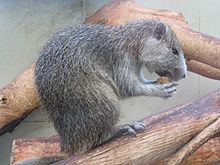Hutia
| Hutia Temporal range:
| |
|---|---|

| |
| Capromys pilorides | |
| Scientific classification | |
| Domain: | Eukaryota |
| Kingdom: | Animalia |
| Phylum: | Chordata |
| Class: | Mammalia |
| Order: | Rodentia |
| Superfamily: | Octodontoidea |
| Family: | Capromyidae Smith, 1842 |
| Genera | |
|
Capromys | |
Hutias are moderately large cavy-like rodents of the family Capromyidae that inhabit the Caribbean Islands. Most species have a head-and-body length that ranges from 21 to 46 cm (8.3 to 18.1 in) and weigh less than 2 kg (4.4 lb), but Desmarest's hutia has a head-and-body length of 31 to 60 cm (12 to 24 in) and weigh 2.8–8.5 kg (6.2–18.7 lb).[1] Twenty species of hutia have been identified, and at least a third are extinct. (Their larger relatives the giant hutias, of the family Heptaxodontidae, are entirely extinct.) They resemble the nutria in some respects. Tails are present, varying from vestiges to prehensile. They have stout bodies and large heads. Most species are herbivorous, though some consume small animals. Instead of burrowing underground, they nest in trees or rock crevices. Only Desmarest's hutia and the prehensile-tailed hutia remain common and widespread; all other extant species are considered threatened by the IUCN.
They are hunted for food in Cuba, where they are often cooked in a large pot with wild nuts and honey. At the Guantanamo Bay Naval Base however, there is an over population due to the lack of natural predators and an abundant food source. Desmarest's hutias are referred to by those stationed at the Guantanamo Bay Naval Base as banana rats.[2] Banana rats are not named for their dietary preference, but because their feces look like small versions of the fruit. They are known to come out at night.
Species
Those known to be extinct are marked with a dagger.
- Order Rodentia
- Suborder Hystricognathi
- Family Capromyidae
- Subfamily Capromyinae
- Capromys
- Desmarest's hutia (Capromys pilorides)
- Geocapromys
- Bahamian hutia (Geocapromys ingrahami)
- Jamaican hutia (Geocapromys brownii)
- Little Swan Island hutia (†Geocapromys thoracatus)
- Mesocapromys
- Cabrera's hutia (Mesocapromys angelcabrerai)
- Dwarf hutia (Mesocapromys nanus)
- Eared hutia (Mesocapromys auritus)
- San Felipe hutia (Mesocapromys sanfelipensis)
- Mysateles
- Black-tailed hutia (Mysateles melanurus)
- Garrido's hutia (Mysateles garridoi)
- Gundlach's hutia (Mysateles gundlachi)
- Prehensile-tailed hutia (Mysateles prehensilis)
- Southern hutia (Mysateles meridionalis)
- Capromys
- Subfamily †Hexolobodontinae
- †Hexolobodon
- Imposter hutia (†Hexolobodon phenax)
- †Hexolobodon
- Subfamily Isolobodontinae
- †Isolobodon
- Montane hutia (†Isolobodon montanus)
- Puerto Rican hutia (†Isolobodon portoricensis)
- †Isolobodon
- Subfamily Plagiodontinae
- Plagiodontia
- Hispaniolan hutia (Plagiodontia aedium)
- Samana hutia (†Plagiodontia ipnaeum)
- San Rafael hutia (†Plagiodontia araeum)
- †Rhizoplagiodontia
- Lemke's hutia (†Rhizoplagiodontia lemkei)
- Plagiodontia
- Subfamily Capromyinae
- Family Capromyidae
- Suborder Hystricognathi
-
Prehensile-tailed hutia (Mysateles prehensilis)
References
- ^ Nowak, R. M. (1999). Walker's Mammals of the World. Vol. 2. 6th edition. pp. 1703-1710. ISBN 0-8018-5789-9
- ^ Larson, Vaughn (23 September 2008). "Sailor Volunteers to Help Base Environment". Joint Task Force Guantanamo Public Affairs. Retrieved 24 September 2011.

